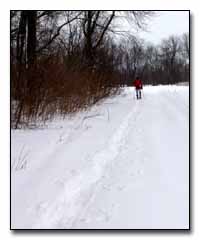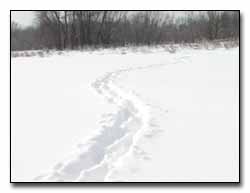|
 Strap on your snowshoes and you can go almost anywhere that you are physically able to go. Take the same scenic walks and hikes that you normally do during the warmer months. It is the easiest snow sport to learn. If you know how to walk, you can snowshoe. Obviously, there are some techniques to learn to help you improve your snowshoeing experience. The key to enjoying your experience is to dress properly and to be well prepared. Read about how to dress properly. You can snowshoe at any pace that you are comfortable with: walking or jogging. If you want to jog, you should consider a shorter snowshoe. Based on your speed, you can burn from 400 to 900 calories per hour. Snowshoeing is an excellent low impact aerobic workout. The following are some snowshoeing hints and tips to help you enjoy snowshoeing.
Strap on your snowshoes and you can go almost anywhere that you are physically able to go. Take the same scenic walks and hikes that you normally do during the warmer months. It is the easiest snow sport to learn. If you know how to walk, you can snowshoe. Obviously, there are some techniques to learn to help you improve your snowshoeing experience. The key to enjoying your experience is to dress properly and to be well prepared. Read about how to dress properly. You can snowshoe at any pace that you are comfortable with: walking or jogging. If you want to jog, you should consider a shorter snowshoe. Based on your speed, you can burn from 400 to 900 calories per hour. Snowshoeing is an excellent low impact aerobic workout. The following are some snowshoeing hints and tips to help you enjoy snowshoeing.
1) Make Sure There Is Enough Snow:
Just because your house is buried in snow, make sure the woods has a sufficient snow base. The woods generally need more snow to fall because the trees protect the trails. Sometimes, the wind even blows some of the snow off the trails. During the warmer days, be careful of underground streams that will appear quite rapidly.
2) Start Slowly:
For the first time, in order to feel comfortable in your snowshoes, start on a packed, flat trail. Experience how it feels to have snowshoes on your feet. Initially, you might have to possibly adjust the position of your snowshoes on your boots.
3) Walk Slowly:
Walk slowly and take small steps. Lift you feet up naturally and walk like you normally do. Don't lunge your feet forward, force your feet forward or leap.
4) Avoiding Stepping On The Tails:
Try not to step on the tails of the forward snowshoe with your forward moving foot as you might find yourself in the snow. The easiest way to stop stepping on your snowshoes is to walk with the snowshoes parallel to each other.
5) Try Not To Look Down:
Your experience with snowshoes is the ability to see places that you normally are not able to see. You will not fall if you look ahead so try looking ahead as soon as possible.
6) Backing Up Is Impossible:
Backing up is extremely hard to do as the tail of the snowshoe always gets stuck in the snow. This might cause you to fall. It is easily to go in a small circle to turn yourself around. You can use the same technique as skiers do by raising your left leg and twisting it to face the opposite way. Then lift your right leg and face it the opposite way. I don't recommend this technique for first time users.
7) Share The Load:
When you are snowshoeing with a partner or a group, it is much easier to follow someone when breaking a trail. The first person should take small, consistent steps and the second person will directly follow the first person's trail. You will notice that it is much easier for the rest of the people to follow the first person as the first person is doing all the work. Depending on the depth of the snow and the steepness of the trail, switch places before the first person becomes exhausted. You will notice that your speed will be much faster using this technique.
8) Use Poles:
You can use the same hiking poles that you own, remove the existing baskets, and attach snow baskets. The hiking poles work great through the winter snow. If you don't own hiking poles, you can use your ski poles. The poles work out the upper body and also act as a brake when you are descending a hill. They also help you climb over logs, streams, etc. The poles also help to reduce wear and tear on your knees and leg muscles.
9) Do Not Travel Straight Across:
It is easier to go up a hill or traverse the hill at an angle. It is much more difficult to travel straight across a hill. When going up a steep hill, traverse back and forth at a 45 degree angle.
10) Know The Trail:
The snow covered trail will look different from the trail you might be used to in the spring or summer. Be sure you know how to get in and get out. Be sure to take a map with you if a map is available. If you have a GPS, it is useful to bring. Read about what to bring.
11) Tell Someone Where You Are Going:
Always let someone know where you are going and when you will return. Many unfortunate accidents could have been spared if that person let someone know where and when.
 12) Stretch And Warm Up:
12) Stretch And Warm Up:
Stretch your calves and thighs simply for a few minutes before you start. It will help loosen up those muscles and avoid any sprains, strains, pulled muscles or spasms.
13) Descending:
When descending, have your knees slightly bent and the weight of your body slightly back on the rear of the tails. Do not sit too far back as your snowshoes could come out right from under you. Use your poles as a brake as you progress down the slope.
14) Not Meant To Be Used On The Side:
Snowshoes are not meant to be used on their side. The strongest position of the snowshoe is when the whole bottom rests on the snow. Any time you find yourself with part of the snowshoe raised from the snow, it is less stable.
15) Gradually Prevents Sinking:
If you find yourself in deep snow, let your snowshoe down slowly into 3-6" of snow. Pause for a second and let the rest of your weight down. The original snow that was packed before you let the rest of your weight down will pack down somewhat and support you a little better than letting all your weight down at once.
16) Kick In:
If you find yourself having to go up a steep slope because the trail is narrow, kick the front of your snowshoe into the snow. Press down at the same time. This creates steps that will help you climb the steep slope. Make sure you place each foot far enough ahead so the steps do not collapse.
17) Try The Herring Bone:
If it is difficult to climb a steep slope, you might try the herringbone step similar to what skiers do to climb a hill. I don't recommend this step until you feel very comfortable in your snowshoes.
18) Be Familiar With Hypothermia:
Be sure you know the signs of hypothermia. Always keep your head, hands and feet warm as that is where you lose heat the fastest.
19) Check The Weather Report:
Always check the weather report just before you leave. Listening to the weather the night before will do you no good as we all know the weather can change at any moment.
20) Daylight Is Shorter:
Remember during the winter, the day is shorter. Always start back a little sooner than later. It is quite difficult to navigate if it is dusk.
21) Don't Depend On Your Tracks:
Don't depend on your tracks to lead you back to the start. During a blizzard, there may not be any tracks to follow back.
22) Don't Over Tighten:
Don't over tighten your snowshoe straps. This might cut off the circulation on your feet and cause unnecessary coldness. Tighten your straps just enough to hold your boots.
| 
